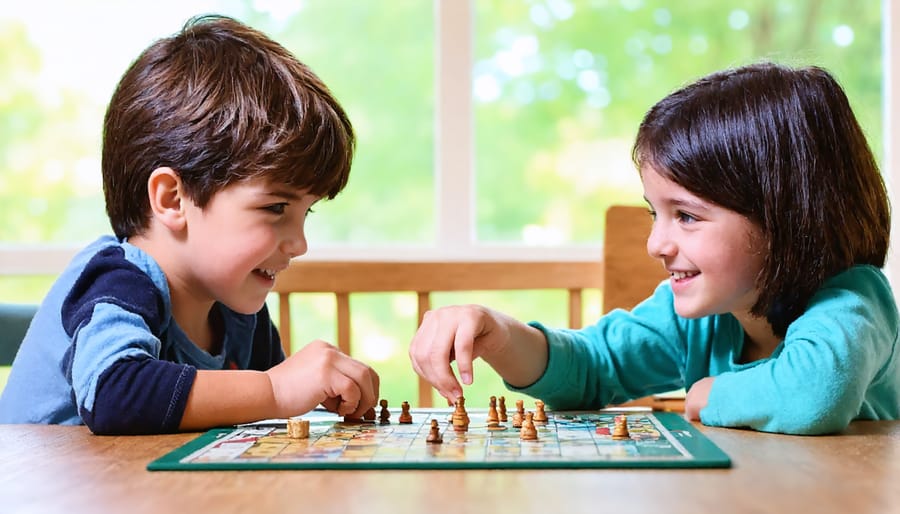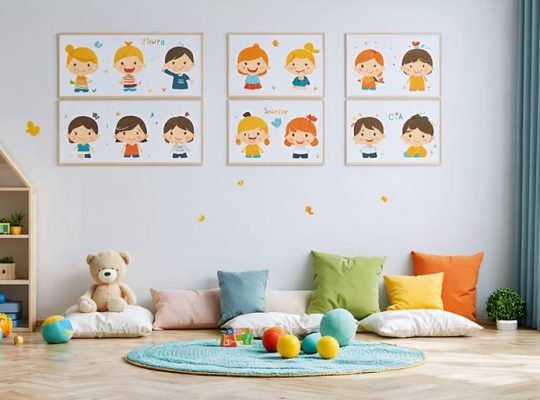Watch your children interact at different ages and stages, and you’ll notice distinct patterns emerge in their family dynamics. From the fierce protector to the competitive challenger, sibling relationships shape our children’s emotional development in profound ways. These early bonds create the foundation for how our kids will navigate relationships throughout their lives.
Understanding the five distinct types of sibling relationships empowers parents to nurture healthy connections between their children. Whether you’re witnessing the natural leadership of an older sibling or managing the delicate balance between twins, recognizing these patterns helps you respond more effectively to your children’s needs.
Each sibling dynamic brings its own challenges and opportunities. Some siblings naturally fall into supportive roles, while others might struggle with rivalry or competition. By identifying which relationship pattern exists between your children, you can implement targeted strategies to strengthen their bond and address potential conflicts before they escalate.
As we explore these five relationship types, you’ll discover practical tools to foster positive interactions and help your children build lasting, meaningful connections with their siblings. These insights will transform how you approach sibling relationships in your home, creating a more harmonious family environment for everyone.
The Close-Knit Connection

Signs of a Healthy Bond
When siblings share strong emotional bonds, certain positive behaviors and attitudes become evident in their daily interactions. You’ll notice frequent displays of affection, such as hugs, kind words, and genuine concern for each other’s well-being. These siblings often choose to spend time together willingly, sharing activities and creating special memories even without parental encouragement.
Healthy sibling relationships typically feature open communication, where brothers and sisters feel comfortable expressing their feelings and resolving conflicts constructively. They demonstrate mutual respect by acknowledging each other’s boundaries, personal space, and belongings. You might observe them celebrating each other’s achievements without jealousy and offering comfort during difficult times.
Another key indicator is their ability to work as a team while maintaining their individual identities. These siblings support one another’s growth while understanding that it’s normal to have different interests and friend groups. They show loyalty by defending each other outside the home and keeping shared confidences, creating a foundation of trust that often lasts well into adulthood.
Nurturing Close Connections
Parents play a crucial role in fostering healthy relationships between siblings. Creating opportunities for positive interactions is key – schedule regular family game nights or shared activities where children can bond through fun experiences. Encourage cooperation rather than competition by assigning team projects or shared responsibilities that require working together.
Make time for individual attention with each child to reduce rivalry and feelings of competition for parental attention. When children feel secure in their relationship with parents, they’re more likely to develop positive connections with siblings.
Model healthy conflict resolution and communication skills. When disagreements arise, help children express their feelings respectfully and work toward solutions together. Celebrate each child’s unique qualities while highlighting their complementary strengths as siblings.
Create family traditions that involve all siblings, such as special weekend breakfasts or holiday customs. These shared experiences build lasting memories and strengthen family bonds. Avoid comparisons between siblings and instead focus on each child’s individual growth and achievements.
Remember that strong sibling relationships take time to develop. Stay patient and consistent in supporting positive interactions, and celebrate small improvements in how your children relate to each other.
The Competitive Dynamic
Healthy vs. Harmful Competition
Competition between siblings is natural and can even be beneficial when channeled positively. Dr. Sarah Mitchell, a family therapist, explains, “Healthy competition can motivate children to try harder and develop new skills, while teaching them valuable lessons about sportsmanship and resilience.”
Healthy competition includes friendly games, academic challenges where both siblings encourage each other, and activities that end with high-fives rather than tears. These interactions help children develop problem-solving skills and emotional regulation.
However, parents should watch for signs of harmful competition, such as constant one-upmanship, deliberate sabotage of a sibling’s success, or extreme emotional reactions to losing. When one child consistently feels inferior or becomes overly aggressive, it’s time to intervene.
“The key difference lies in the aftermath,” notes child psychologist David Cohen. “After healthy competition, siblings remain friends and can celebrate each other’s successes. Harmful competition leaves lasting emotional wounds and damages their relationship.”
Parents can promote healthy competition by establishing clear rules, celebrating individual strengths, and teaching children to support each other’s achievements.

Managing Sibling Rivalry
Managing sibling rivalry requires patience, consistency, and a balanced approach. Start by acknowledging each child’s feelings without taking sides. When conflicts arise, encourage your children to express their emotions using “I feel” statements rather than blame.
Create opportunities for cooperation rather than competition. Set up activities where siblings must work together to achieve a goal, like completing a puzzle or preparing a meal. This builds teamwork and mutual appreciation.
Avoid comparing your children to each other, even with positive intentions. Each child is unique, and comparisons can fuel rivalry and resentment. Instead, celebrate individual achievements and qualities.
Establish clear family rules about acceptable behavior and consistent consequences for breaking them. When conflicts occur, guide children through problem-solving steps rather than solving issues for them.
Make time for one-on-one attention with each child. This helps reduce competition for parental attention and strengthens your individual bonds. Remember that some rivalry is normal and can actually help children develop important social skills like negotiation and compromise.
Consider family meetings as a forum where everyone can voice concerns and work together to find solutions. This teaches children valuable conflict resolution skills they can use throughout their lives.
The Distant Relationship
Understanding Distance
Emotional distance between siblings can develop for various reasons, and understanding these factors is crucial for parents seeking to nurture stronger family bonds. Life transitions, such as moving away for college or starting a new family, often create physical separation that can lead to emotional gaps. Different life experiences and personal values may cause siblings to drift apart, especially when their choices or lifestyles significantly differ.
Unresolved childhood conflicts or perceived favoritism can create lasting emotional barriers. Sometimes, siblings struggle to move past historical hurts, leading to protective emotional withdrawal. Family dynamics, including divorce or remarriage, can also impact sibling closeness, as children may align with different parents or struggle to adapt to new family structures.
Communication patterns play a vital role – siblings who don’t regularly share their thoughts, feelings, and experiences naturally become less connected over time. However, it’s important to remember that distance doesn’t have to be permanent. With awareness and effort, siblings can bridge these gaps through open dialogue, shared experiences, and a willingness to understand each other’s perspectives. Professional family counseling can also help siblings reconnect and heal past wounds.
Building Bridges
Building strong connections between siblings requires intentional effort and support from parents. Start by creating regular opportunities for shared positive experiences, such as family game nights or collaborative projects. These activities help siblings build memories and develop mutual interests.
Encourage open communication by establishing family meetings where siblings can express their feelings and concerns in a safe space. Teaching active listening skills and empathy can help children better understand each other’s perspectives.
Consider implementing a “special time” system where siblings take turns choosing activities to do together, fostering mutual respect and understanding. This approach helps each child feel valued while strengthening their bond.
Parents can also model positive relationship behaviors and praise siblings when they demonstrate kindness, cooperation, or support for one another. Simple actions like helping with homework or sharing toys deserve recognition and reinforcement.
For siblings with existing tensions, focus on highlighting their complementary strengths and creating situations where they need to work together to achieve common goals. This collaborative approach helps build trust and appreciation for each other’s unique qualities.
Finally, remember that building stronger sibling relationships takes time and patience. Celebrate small improvements and maintain consistent support for their developing connection.

The Caretaker Dynamic
Benefits and Challenges
Understanding sibling caretaking dynamics reveals both positive and challenging aspects that shape children’s development. When older siblings take on nurturing roles, they often develop enhanced empathy, leadership skills, and emotional intelligence. These experiences can foster deep bonds that last a lifetime and prepare them for future caregiving responsibilities.
However, it’s essential to recognize potential drawbacks. Excessive caregiving responsibilities might overwhelm older siblings, potentially leading to stress or resentment. This dynamic can become one of several challenging family patterns if not properly balanced. Younger siblings might struggle with independence or feel overshadowed by their caretaking brother or sister.
The key lies in finding the right balance. Parents can support healthy sibling relationships by acknowledging both children’s needs, setting appropriate boundaries, and ensuring caregiving responsibilities don’t interfere with normal childhood experiences. When managed thoughtfully, these relationships can create strong family bonds while allowing each child to develop their unique identity and strengths.
Maintaining Balance
When siblings take on caretaking roles, maintaining healthy boundaries becomes crucial for both parties’ emotional well-being. While it’s natural for older siblings to feel protective and nurturing towards younger ones, excessive caretaking responsibilities can lead to burnout and resentment if not properly balanced.
Parents can help foster this balance by acknowledging and appreciating the caretaking sibling’s efforts while ensuring they don’t shoulder too much responsibility. Encourage open communication about feelings and needs, and make sure the caretaking sibling has time for their own activities and friendships.
Dr. Sarah Thompson, a family therapist, suggests: “Creating designated ‘me time’ for caretaking siblings helps prevent emotional exhaustion. It’s okay to step back sometimes.”
Setting clear expectations about responsibilities and involving all siblings in age-appropriate family duties can help distribute the emotional load more evenly. Remember that while sibling care can strengthen bonds, it shouldn’t come at the cost of childhood experiences or personal development.
Consider establishing regular family check-ins to ensure everyone’s needs are being met and adjusting dynamics as children grow and circumstances change.
The Conflicted Bond
Root Causes
Understanding the root causes of sibling relationships helps parents address underlying issues and foster healthier connections between their children. Common sources of ongoing conflict often stem from developmental stages, family dynamics, and individual personalities.
Competition for parental attention is a primary driver of sibling tension. Children naturally seek validation and recognition from their parents, and when they perceive favoritism or unequal treatment, it can lead to lasting resentment. As one child development expert notes, “Even subtle differences in how parents respond to their children can impact sibling relationships for years to come.”
Birth order and age gaps also play significant roles. Older siblings may feel displaced when younger ones arrive, while younger siblings might struggle with living in their older sibling’s shadow. Different developmental needs and abilities can create misunderstandings and frustration between siblings.
Individual temperaments and personality differences can either complement or clash. Some siblings naturally mesh well, while others may find it challenging to understand and accept their differences. Family stress, such as divorce, moves, or financial difficulties, can intensify sibling conflicts as children process these changes differently.
Environmental factors, including parenting styles and family communication patterns, significantly influence how siblings interact and resolve conflicts. Creating an atmosphere of open dialogue and emotional safety helps siblings develop stronger bonds and better understanding of each other.
Resolution Strategies
When siblings experience conflict, there are several effective strategies for rebuilding and strengthening their relationships. Open communication is crucial – encourage siblings to express their feelings safely and listen to each other without judgment. Setting aside regular “sibling time” for positive interactions can help create new, happier memories and patterns of behavior.
Parents play a vital role in supporting healthy relationships between siblings. Establish clear family rules about respect and conflict resolution, and model these behaviors consistently. Consider implementing a “cooling off” period during heated moments, followed by guided discussions where each sibling can share their perspective.
For adult siblings working to repair strained relationships, professional family therapy can provide valuable tools and neutral ground for addressing long-standing issues. Small steps matter – starting with brief, positive interactions and gradually building trust can lead to meaningful improvements. Remember that healing takes time, and celebrating small victories along the way helps maintain momentum toward stronger sibling bonds.
Understanding sibling relationships helps us nurture stronger family bonds and support our children’s emotional well-being. Whether your children share a close friendship, maintain a competitive spirit, or struggle with conflict, remember that these dynamics aren’t set in stone. Every relationship has the potential for positive growth and change.
By recognizing these five distinct patterns of sibling relationships, parents can better support their children’s unique needs and foster healthier connections. Focus on celebrating each child’s individuality while encouraging mutual respect and understanding. Create opportunities for positive interactions, establish clear boundaries, and model the behavior you wish to see.
Remember, even challenging sibling relationships can improve with patience, consistent support, and the right guidance. Your role in fostering these connections today helps build the foundation for lifelong family bonds tomorrow.







